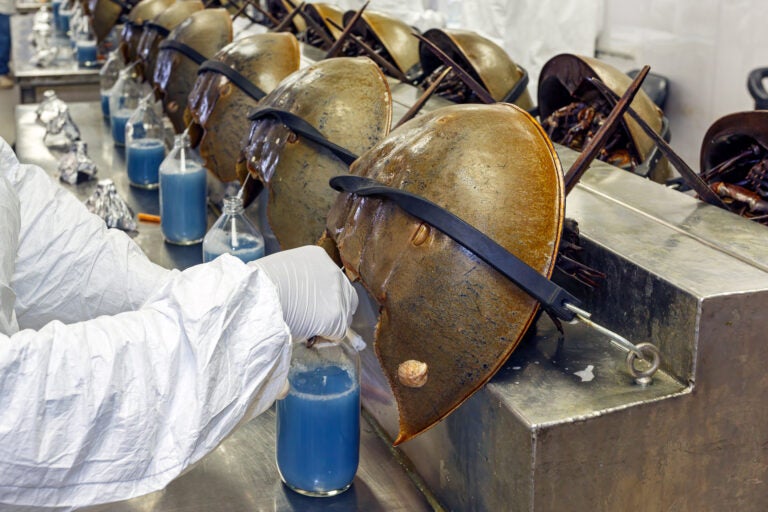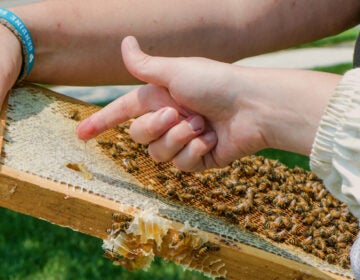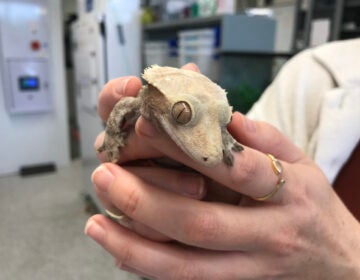Vaccines are still tested with horseshoe crab blood. The industry is finally changing

Horseshoe crabs are bled alive at a facility in Charleston, S.C., in June 2014. (Ariane Müller)
Pharmeceutical companies could soon have easier access to synthetic alternatives to horseshoe crab blood, a key ingredient used to test vaccines and medical devices for contamination.
The U.S. Pharmacopeia, the regulatory body in charge of setting national safety standards, announced a proposal on Aug. 22 that would make it simpler for companies to use the alternatives. The new standard, which is expected to take effect in early 2024, is one of several changes enacted since NPR reported in June on the lack of oversight in the horseshoe crab blood harvest on the east coast, including in areas where the crabs’ eggs are considered an important food source for rare birds.
The blue blood of the horseshoe crab clots when it comes into contact with bacterial toxins, which helps technicians identify contaminated products. A synthetic alternative to the blood-derived testing ingredient, called limulus amoebocyte lysate, or LAL, was invented decades ago. Alternatives have since become mainstream; most of the east coast bleeding companies now also sell tests made with a synthetic, not just LAL, and the European Pharmacopoeia considered the synthetic ingredient equivalent to the crab-derived one in 2020. But since scientists at the U. S. Pharmacopeia had not yet done the same, drug companies that wanted to use them faced extra regulatory hurdles in the U.S..
“We hope that this will be an encouragement for companies to continue switching to non-animal-derived reagents,” said Jaap Venema, the group’s chief science officer. “We’re only expanding opportunities for companies to start using them.”
Two days later, environmental groups announced a landmark settlement in a lawsuit against the South Carolina Department of Natural Resources and Charles River Laboratories, a multinational biomedical company that provides the pharmaceutical industry with more than half of its supply of LAL.
The lawsuit alleged that one of the ways the state allowed crabs to be harvested – permitting unlimited amounts of horseshoe crabs to be stored in ponds away from beaches – was harming the crabs and endangering a migratory shore bird called the red knot.
Red knots depend on access to horseshoe crab eggs to fuel their annual migration from the bottom tip of South America to the Canadian Arctic. But the birds can’t find the nutrition-rich eggs on beaches if the crabs that typically lay them there are sequestered during their mating season. Red knot numbers have declined by 94% over the past 40 years, and the species was designated as threatened by the federal government.
Charles River and the Department of Natural Resources denied they were responsible for harm caused to wildlife. But the terms of the settlement require the company to comply with stricter rules than the bleeding industry has typically been held to in South Carolina. For the next five years, the horseshoe crab harvest will be banned across 30 island beaches and harvesters will be prohibited from keeping female crabs in ponds away from the shore. The company will pay an independent monitor to oversee its compliance with the new rules, and fishers must share their harvest locations.
Charles River also agreed not to harvest any horseshoe crabs from the Cape Romain National Wildlife Refuge, near Charleston. A few weeks earlier, the U.S. Fish and Wildlife Service determined that harvesters would no longer be allowed to take crabs from the refuge, marking the first time a federal agency restricted the horseshoe crab harvest to protect the red knots.
“Charles River worked collaboratively with wildlife and environmental groups, as well as the S.C. Department of Natural Resources, to align on the best approach for protecting natural resources, while ensuring access to life-saving LAL to protect the medicines and medical devices used by patients worldwide,” wrote a company representative in a statement emailed to NPR.
Catherine Wannamaker, the lawyer for the Southern Environmental Law Center who led the litigation, called the settlement a major accomplishment for conservation efforts and attributed the result in part to the reporting on problems with the harvest.
“We just feel very proud of getting to this point where they believe they can still do their business, but we are able to protect this bird that really needs these eggs,” Wannamaker said. “I think this started with the news coverage, and then people got interested and local organizations got concerned and then it all went from there.”




